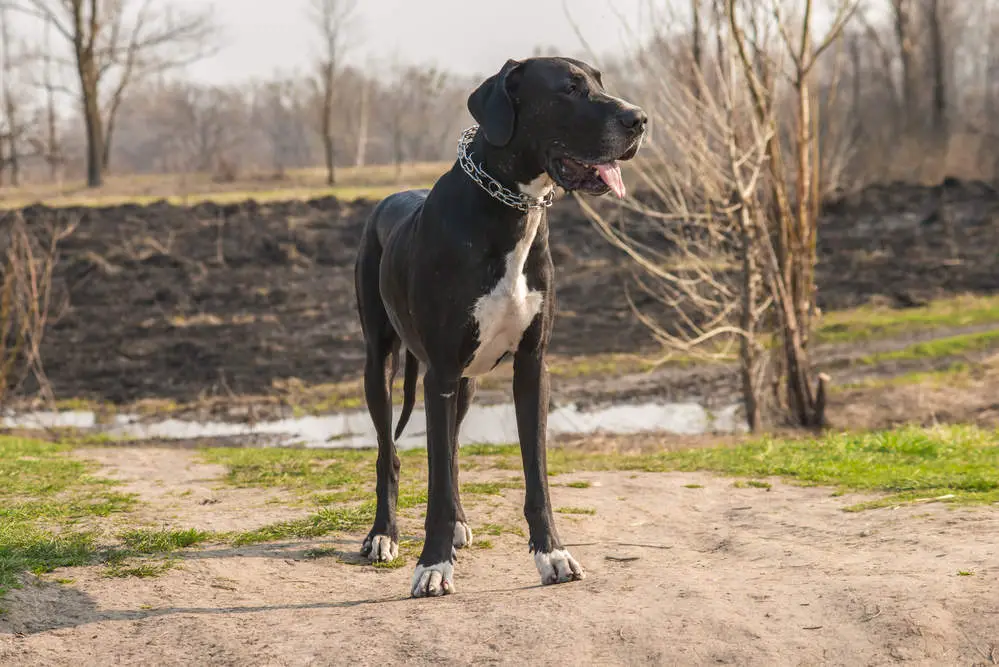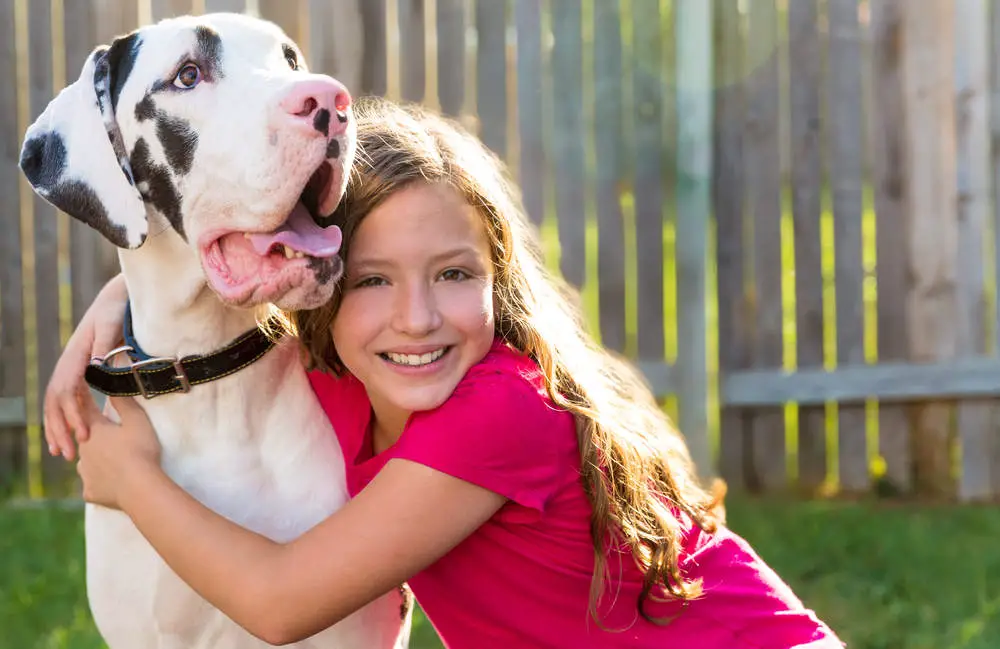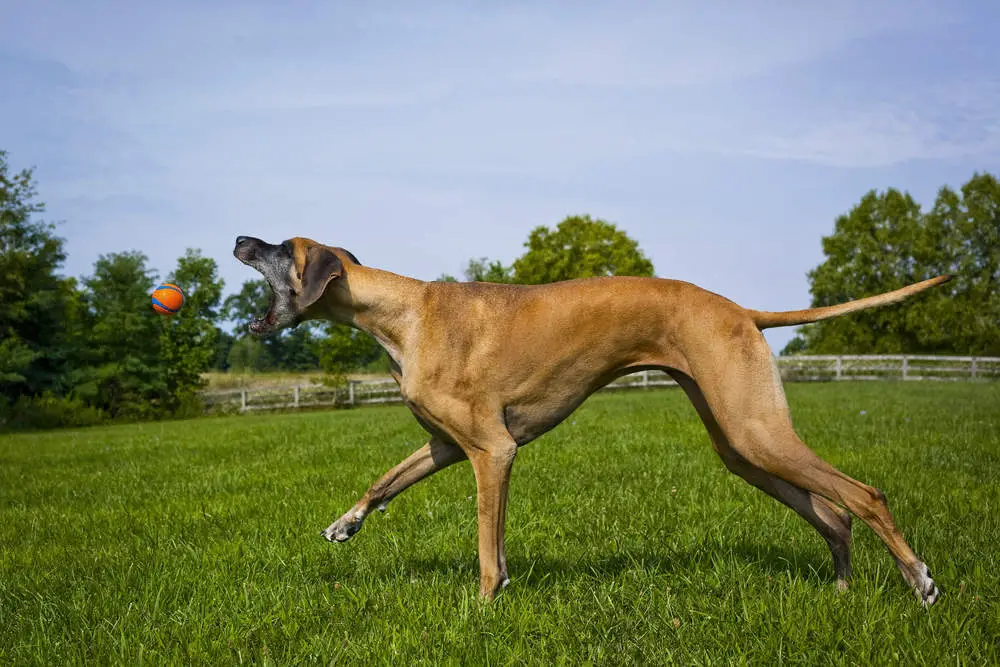
Great Danes are one of the largest dog breeds but they are called gentle giants. These fascinating working breed dogs are quite popular and despite their size—which can make you feel like you have a pony in the house—they actually do pretty well in most households.
And even though they are loyal, loving and joyful, you should do your due diligence before you decide to get one of these as your pet (as you should with any breed). So, let’s dive in and find out a few essentials about the breed, shall we?
Great Dane: At a Glance
- Height: 28 to 34 inches
- Weight: 110 to 140 pounds (females); 140-175 pounds (males)
- Lifespan: 7 to 10 years
- Temperament: Joyful, loyal
- Appearance: Short and flat coat, needs low grooming, comes in fawn, black, blue and harlequin
- Dog Group: Working
Origins
The story of the Great Dane dogs has really ancient origins. They say it goes back to drawings found in Babylonian temples around 2000 BC.
These dogs were said to have traveled the world first with Assyrians and then with the Romans and Greeks.
But the modern-day leg of that story begins in Germany where Great Danes were used as boar hunters and were also referred to as boarhounds and were used to hold the boar when the hunter was still on their way.
But the present-day dog is supposedly the result of a mix between the Irish Wolfhound/Greyhound and the English Mastiff. That’s why Italians continue to call it ‘alano’ which means Mastiff.
Towards the late 1800s, Great Danes made their way to the US. But they were officially recognized by the American Kennel Club only in 1887.
Two years later in 1889, the Great Dane Club of America was formed and it became the fourth breed club to join the AKC.
Today, they are no longer considered worker dogs because, over time, German breeders made them less aggressive leading them to be the gentle creatures that walk the planet. While they are still excellent watchdogs, they are also wonderful companion animals.
Fun Fact #1: At 44 inches, a Great Dane called Zeus holds the Guinness record for being the world’s tallest dog. These dogs have also been seen in the movie versions of Sir Arthur Conan Doyle’s short story The Hound of Baskervilles.
Great Danes have also appeared in pop culture as a cartoon dog Scooby-Doo and as comic-strip character Marmaduke.
Find more general articles about Great Danes below:
- How Big Do Great Danes Get?
- 7 Officially Recognized Great Dane Colors
- 21 of the Best Great Dane Mix Breeds
- Great Dane Pug Mix Breed Guide
- Great Dane vs Doberman: Which Is Right For You?
- When Do Great Danes Stop Growing?
- Do Great Danes Drool?
Temperament and Behavior

As mentioned before, they are called gentle giants because they are sweet and loving pets that love to play and relax with kids. They are easy to train because they are people pleasers.
Great Danes like being with families and get along quite well with strangers too. But make no mistake, they are very protective and can get a bit shifty if they feel like you need to be defended.
But Great Danes must be socialized when they are still puppies so that they come into contact with different people, experiences and even sounds. This helps the pup grow into a well-rounded adult.
Taking them to parks and other busy areas for walks and getting them acquainted with visitors is an excellent way to do this. Allow them to come in contact with other dogs too.
Because of their size, they need a lot of space to move around which means small apartments are uncomfortable for them. And it is tough to hide things from Great Danes because they can reach almost anything at a height inside a house.
It’s not a good idea to take them for a jog or a run with you till they are at least a year and a half old because it takes time for the bones to grow and stabilize in large dogs.
They are not very aware of how big they are. So, keep a close eye on adult Danes when there is a possibility of jumping or pulling the leash.
A six-foot fence should be enough because, thankfully, they are not likely to jump it.
They are pretty great with kids except they might accidentally knock over little ones which something to keep an eye out for. They are also good with other pets when raised with them.
Fun Fact #2: Sometimes, they do behave like little lap dogs trying to get to you even if you move.
Find more articles about your Great Dane’s temperament and behavior below:
- Are Great Danes Good With Small Dogs?
- Why Do Great Danes Sit on Everything?
- Are Great Danes Loyal to Their Owners?
- Do Great Danes Get Attached to One Person?
Diet and Nutrition
Since they are large breed dogs, you need to find food that is appropriate for the breed. The right kind of food will make sure that the puppies grow out to their correct, healthy size.
The pups need three meals a day but you need to figure out the type of diet, a schedule for it and the quantity with your vet and breeder. Once they are adults, Great Danes are given 10 cups of food every day.
They should be eating at least two times a day and a bit more if possible. One large meal or freely feeding on food is not the way to do it.
If they eat too much or too quickly Danes experience gas trouble which can lead to torsion which is something to watch out for. You must always get them high-quality food and keep the table scraps to a minimum.
Avoid high-fat foods and cooked bones if possible. You must also figure out with your vet which human foods are okay for them to consume.
Bloating is a lethal problem among Danes and it is unclear what exactly causes it. So, be extra careful with the food, give them a few small meals during the day and don’t let them exercise right after a meal.
Training and Exercise

Danes look pretty calm and sedate but they need to exercise according to their age. Typically, a little brisk walking a couple of times a day is good enough but not during mealtime.
They have a really good sense of smell and tend to follow it. So, keeping them on a leash while outdoors is a really good idea and a recommended practice.
They are good companions for jogging and hiking once they are of the right age. Danes are agile, obedient and do a good job with weight-pulling events too.
They are playful dogs with good bones and joints once they are fully formed but with age, their energy levels drop to moderate. It is easy to train them in the house and crate training is highly recommended.
Find more articles about training and exercising your Great Dane below:
Grooming
It is pretty easy to take care of Danes because they have a short and flat coat that needs to be brushed on a weekly basis. Some Danes do shed regularly but the weekly brushing will take care of it.
But be mindful that they do shed heavily in spring and fall. But brushing it keeps the loose hair out and your dog healthy and clean.
You need to give them a bath once or twice a month. Get a firm bristle brush and a shampoo for that.
Sometimes they are not up for it and try to hide but their size is their greatest disadvantage. Nevertheless, get them used to a bath early on.
Naturally, their ears are floppy and they need routine cleaning and checks. You might find some Danes with cropped ears which is a surgical alteration and is banned in some countries.
You must trim their nails once every two weeks so that they don’t end up split or torn. And brush their teeth a few times every week so that you avoid the risk of gum diseases.
Check their paws and examine their mouth often to make sure you’re not caught off-guard. They might not like this so praise them and maybe give them a reward after you check them.
Health Conditions
These are pretty healthy dogs but there are a few conditions that you must be aware of. It’s just part of the due diligence you must do as a pet owner-to-be.
- Hip Dysplasia: This is a hereditary condition where the hip joint and the thigh bone are at odds with each other. It causes pain and your dog could even develop lameness in the back. It can be diagnosed from an X-ray and might lead to arthritis over time. Such dogs are not meant to be bred.
- Development Issues: Giving them an improper diet as puppies can lead to a lot of growth problems that affect their joints and bones. Keep an eye on the protein and calcium levels in the food.
- Torsion or Bloat: This can be life threatening for dogs with a deep chest like Great Danes. If they have large meals or exercise at mealtimes, this is a real problem.
This condition is also called bloat and is more common in older Danes but you must develop healthy eating patterns early on to avoid the risk. In this condition, their stomach is filled with gas and then gets twisted.
They suffer trying to get rid of the extra air and this affects their blood pressure which takes them into shock. If they’re salivating excessively or trying to throw up, take them to the vet immediately.
- Heart Disease: From dilated cardiomyopathy to mitral valve defects, there are a variety of heart problems that affect Great Danes. The treatment is quite specific and depends on the condition, the Dane’s age and general health. If it gets to the point of needing surgery, find a vet who can operate on large dogs.
- Bone Cancer: Also called osteosarcoma, this is a bone tumor condition that is usually detected in middle-aged or senior dogs. But with Danes, it can happen at any point in their lifetime.
This is an aggressive bone cancer that can be diagnosed from X-rays and it affects their limbs. Amputation and chemotherapy are both options and help them live nine months to two years longer.
Should I Get One?
As with all breeds, there are some really wonderful things and a few downsides to having a Great Dane as a pet. Take a look.
Pros
- Danes are really good with families and kids. In fact, they are capable of developing a strong bond with children.
- They are protective but are not overly suspicious of strangers.
- Great Danes are good guard dogs with the right training from an experienced breeder or trainer.
- They have an intimidating bark that can scare intruders.
- Great Danes are really good with other pets when they are socialized from an early age.
- They have a short and smooth coat that needs to be brushed only once a week with a soft brush.
- Danes need to shower even less frequently than that and it is easy to find a shampoo for them since they are not prone to allergies.
Cons
- They are wonderful dogs but Danes don’t live long which means you must be ready to let them go in just a few short years.
- Danes have a few serious health issues that can even cause death. Even when not lethal, they tend to have bone and joint problems that need care.
- They need to be fed a few times a day so that they don’t get torsion or bloat which means you need to make time and plan their meals.
- Great Danes need to be trained properly so that they are not overly shy or aggressive towards visitors, kids and other pets.
- Because of their size, unruly Danes are difficult to control.
- It is expensive to raise a Dane because of the bills of high-quality food for large dogs. Bigger accessories like collars are also more expensive.
Parting Thoughts
Great Danes are large but loving dogs that love people. They are smart and can be trained at home.
They are really good with families but are also protective. They are really good with strangers except when they suspect that you are in danger.
They can be ferocious dogs but not a danger if socialized well and early. They are really good with kids too except they are really big and can accidentally hurt infants.
Great Danes are really loving dogs and give you lots of sweet memories even if they don’t live as long as some other breeds.
